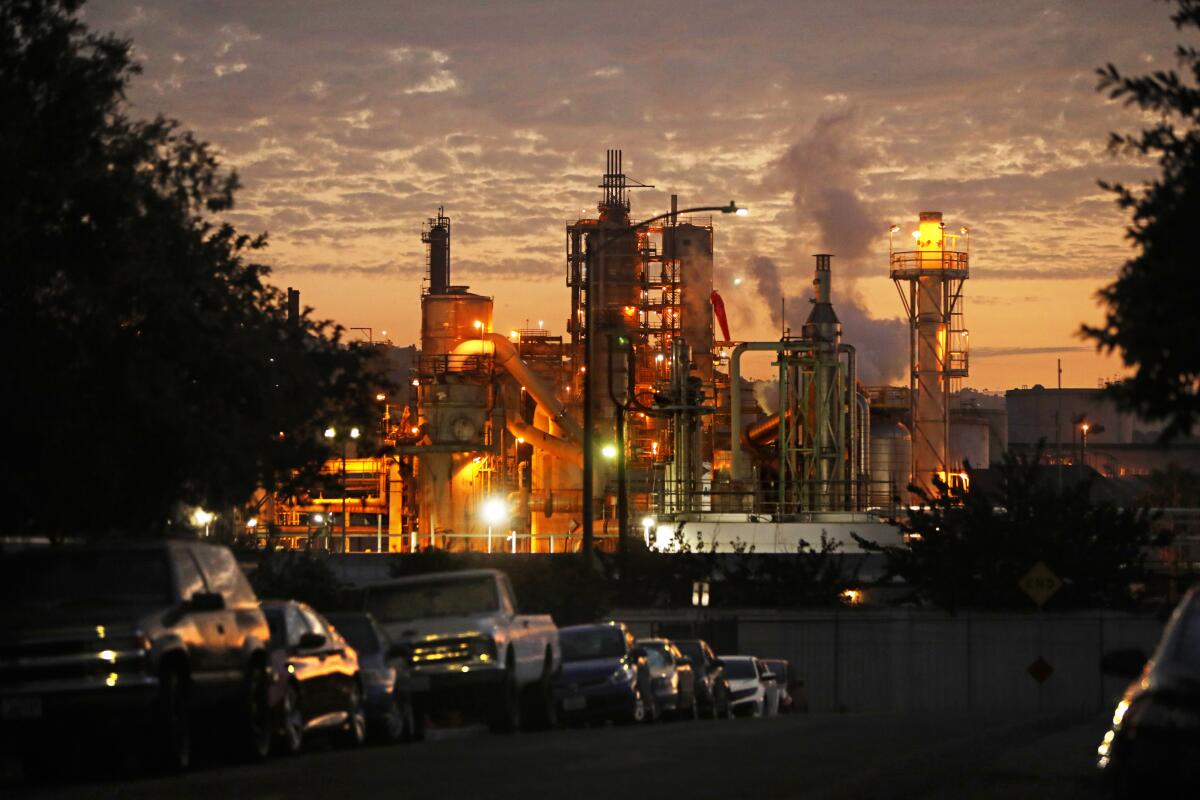The South Bay is in for a large-scale transformation near the Port of Los Angeles as Phillips 66 shuts down its sprawling refineries and makes way for developers to reimagine the prime real estate.
Potential replacements for the century-old refinery complex covering 650 acres include housing and last-mile distribution centers for e-commerce merchants, both of which are in high demand. There may be shops, restaurants, and sports and entertainment venues.
“It’s a tremendous opportunity,” real estate analyst Jesse Gundersheim said. “Where else are you going to find hundred of acres of developable land in L.A or coastal California?”
Oil giant Phillips 66 announced last month that late next year it will close the twin refineries in Carson and Wilmington that produce about 8% of the state’s gasoline. About 900 workers currently operate the refinery, which also produces diesel and jet fuel.

The Phillip 66 refinery in Wilmington was built in 1919 and produces produces gasoline, diesel and aviation fuels, which are distributed by pipeline and by truck to customers in California, Nevada, and Arizona. Wilmington has one of the highest ozone levels in the United States.
(Carolyn Cole/Los Angeles Times)
The refinery’s massive fuel storage tanks, distillation towers and sprawling pipeline have been a long-standing source of community concern. In recent years, complaints of acrid odors, fiery accidents, soot and harmful emissions have gained new resonance as public officials become more sensitive to accusations of environmental damage.
“Phillips 66 in L.A. is an old refinery. It’s had a lot of problems with flaring and fires in recent years and high levels of pollution,” Julia May, senior scientist for Communities for a Better Environment told The Times. “It may have just been out-competed by the rest of the refineries.”
Asked if the site might be more valuable to Phillips 66 as developed real estate than as a refinery, company spokesman Al Ortiz said in an email, “We feel this is the best option for the future of our Los Angeles facilities.”
Ortiz declined to comment further, saying Phillips 66 is in the preliminary stages of the project and hasn’t set a timeline on how long it might take to redevelop the land.
The oil company did say last month that it has has engaged real estate companies Catellus Development Corp. and Deca Cos. to evaluate potential future uses for the site. Both have taken on industrial land makeovers in the past.
Catellus redeveloped the 200-acre former Pacific Refinery Co. near San Francisco into a residential subdivision called Victoria by the Bay in 2003, a process that involved the removal of contaminants, real estate data provider CoStar said.
Deca has transformed outdated sites to accommodate new technologies. Its 800 Cesar Chavez project on San Francisco’s waterfront converted an aging warehouse into a large electronic vehicle charging and maintenance facility. It opened in 2018.
Deca didn’t respond to a request for comment about potential uses of the Phillips 66 site and Catullus referred inquiries to Phillips 66.
“Right now, we are focused on running the facilities and collaborating with Catellus and Deca to get the necessary permits to redevelop the site,” said,” Ortiz said.
There is enough land for several uses, said Gundersheim, CoStar’s senior director of market analytics and a specialist in evaluating industrial real estate.
The Carson site may lend itself best to warehouses, which are always in demand around the nearby Port of Los Angeles, the busiest container port in the Western Hemisphere, Gundersheim said. The facilities may be used by importers collecting goods from China before distributing them across the West Coast or by e-commerce companies such as Amazon to store and quickly distribute goods to customers in the South Bay.
The Wilmington refinery site, which is connected to Carson’s plant by a pipeline, may lend itself to housing. It is bordered by golf courses, Los Angeles Harbor College, federally owned land and residential neighborhoods.
There is a model for such redevelopment not far away, Gundersheim said.
Huntington Beach, which was once a booming oil industry center, has approved construction of 250 residential units alongside a hotel and retail space on the site of a former oil pumping and storage facility on Pacific Coast Highway. It will include single-family homes and apartments intended to be affordable.
Developer Shopoff Realty Investments bought the land in 2016, removed oil tanks and cleaned up the land known as the Magnolia Tank Farm.
The vastly larger Phillips 66 refinery sites may also be turned into a mix of uses that could include golf courses, athletic facilities, shopping centers and entertainment venues blended into new communities with houses and apartments, Gundersheim said.
“This kind of opportunity hasn’t been around for some time,” he said.
Phillips 66, which has operated the refineries since its 2012 spin off from ConocoPhillips, said it would replace their output with sources “inside and outside its refining network” and with renewable diesel and sustainable aviation fuels from its San Francisco Bay Area refinery.




